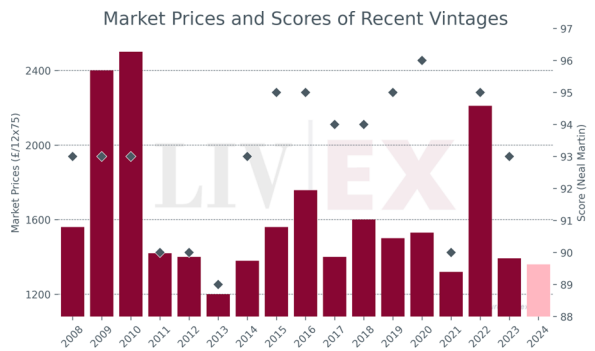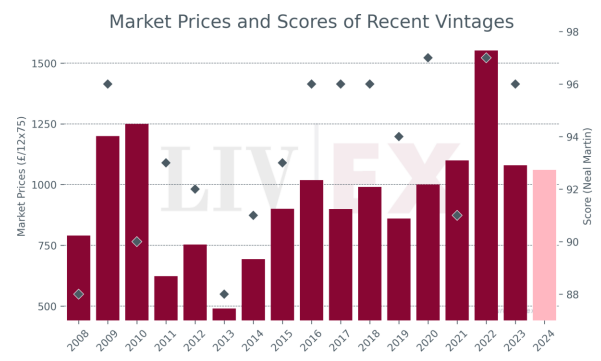Now that the trade are back from en primeur tastings and critic scores are gradually being released, thoughts are turning to how this year’s campaign – and the not insignificant issue of price – will take shape. Last week, we asked the international trade to estimate release prices for a basket of Bordeaux wines. The results of this will be published tomorrow.
In the below post and report, two researchers, Dr. M. Hakan Hekimoğlu of Rensselaer Polytechnic Institute and Dr. Burak Kazaz of Syracuse University’s Whitman School of Management, outline their new approach to predicting release prices using weather information and the Liv-ex 100 index. According to their models, we can expect slight price rises this year on average.
 The study shows that higher temperatures and appreciated values of the Liv-ex 100 index boost en primeur prices while higher levels of rain dampen the release prices. It categorizes the winemakers listed in the Bordeaux 500 index in three groups: First Growth, Left Bank and Right Bank. For the First Growth and Left Bank winemakers, the models produce impressive predictions relying only on temperature, rain, the Liv-ex 100 index and their interactions. When calibrated with data until 2015, their 2016 vintage predictions deviate from the actual en primeur prices by only 5.24% on average. For the Right Bank, their study incorporates barrel tasting scores into the original models; their 2016 vintage predictions deviate by an average of 9.90% from actual en primeur prices.
The study shows that higher temperatures and appreciated values of the Liv-ex 100 index boost en primeur prices while higher levels of rain dampen the release prices. It categorizes the winemakers listed in the Bordeaux 500 index in three groups: First Growth, Left Bank and Right Bank. For the First Growth and Left Bank winemakers, the models produce impressive predictions relying only on temperature, rain, the Liv-ex 100 index and their interactions. When calibrated with data until 2015, their 2016 vintage predictions deviate from the actual en primeur prices by only 5.24% on average. For the Right Bank, their study incorporates barrel tasting scores into the original models; their 2016 vintage predictions deviate by an average of 9.90% from actual en primeur prices.
Last year, Liv-ex surveyed the world’s leading 440 merchants about the value of a basket of 2016 vintage wines including Cheval Blanc, Leoville Las Cases, Mission Haut Brion, Montrose, Mouton Rothschild, Pavie, Pichon Lalande, Pontet Canet and Talbot. The prediction from Hekimoğlu and Kazaz is highly accurate and it deviates only by 0.73% from its actual value (merchants’ error was 4.55%).
The study also provides insights about the upcoming 2017 vintage. Higher temperatures in 2017 (in comparison to 2016) and the 2.2% appreciation in the Liv-ex 100 index from May 2017 to March 2018 push prices up, but a higher level of precipitation dampens their effect. Contrary to the negative perception created by the spring frost of 2017, the study estimates, on average, a 2.02% price increase for the First Growth and a 1.47% increase for the Left Bank winemakers.
Hekimoğlu and Kazaz point out that the Left Bank winemakers were not influenced by the frost as much as the Right Bank winemakers, and therefore, an increase in en primeur prices should not be surprising to the industry. Saint Estephe, Pauillac and Saint Julien escaped any frost damage, and only a few winemakers in Margaux and Pessac Leognan encountered some crop losses. Hekimoğlu and Kazaz state that their data begins in 2001 and the last frost effect was in 1991. To replicate the negative impact of the frost, the study develops conservative models that continue to feature high explanatory power, albeit, with reduced predictive power. These conservative models estimate that the 2017 vintage en primeur prices can get reduced by 3.01% for the First Growth and 6.87% for the Left Bank winemakers.
The study also finds that the en primeur prices for the unclassified Right Bank winemakers rely on tasting expert reviews more heavily than their Left Bank counterparts.
You can download the full report at this link.
Bios
Hakan Hekimoğlu, Ph.D., is an Assistant Professor of Supply Chain Management at the Lally School of Management, Rensselaer Polytechnic Institute in the United States. His publication on wine analytics is considered to be highly influential by wine distributors and it is selected to be re-published in the INFORMS Editor’s Cut.
Burak Kazaz, Ph.D., is the Steven R. Becker Professor of Supply Chain Management and the Laura J. and L. Douglas Meredith Professor of Teaching Excellence, and serves as the Whitman Research Fellow at the Whitman School of Management, Syracuse University in the United States. His articles won numerous best paper awards, and most recently, he is the recipient of the prestigious Wickham Skinner Prize.



